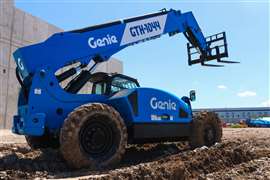Read this article in Français Deutsch Italiano Português Español
Rethinking construction’s most overlooked role: the superintendent
03 November 2025
Construction is in the midst of a labour crisis. As older generations retire, the pipeline of younger talent simply isn’t keeping pace. The reasons are complex but at the heart of the issue lies a matter of perception: many young people view construction work as gruelling, low-tech, and unglamorous.
Despite efforts to revise the perception of the industry through advanced construction technology and cutting-edge digital tools, the stigma remains. And no role suffers more from this image problem than that of the construction superintendent.
Often regarded as a ‘boots-on-the-ground’ authority figure – working in the elements, juggling logistics, coordinating crews – the superintendent is essential yet overlooked. While tech-forward positions like virtual design coordinators or drone operators capture the imagination of a new generation of construction professionals, the superintendent role remains stuck in the past, viewed as old-school, manual, and thankless.
If the construction industry wants to solve its labour shortage and attract fresh talent, one of the tasks it faces is to rethink how it presents the superintendent’s job.
Construction perception vs. reality
Younger generations are growing up in a world shaped by digital innovation, remote work, and flexible career paths. Construction, by contrast, is often perceived as physically demanding, inflexible, and behind the times. These stereotypes, though not entirely fair, are reinforced by the traditional image of certain roles – especially that of the superintendent.
To many outside the industry, the superintendent still represents the ‘old-school’ construction leader, walking the site and barking orders. It’s a demanding job that rarely gets public recognition. And to someone choosing between a tech desk and a job site, the decision can seem obvious.
But the truth is very different. Today’s superintendents are not just taskmasters; they’re communicators, problem-solvers, and leaders. They coordinate people and processes, keep teams aligned, and ensure projects stay safe, efficient, and on schedule. Without them, even the most advanced technology can’t keep a project on track.
That misconception is especially damaging because the superintendent’s role has never been more critical. As construction projects grow more complex, the need for skilled, adaptable leaders in the field continues to increase. Superintendents bridge the gap between the office and the jobsite: interpreting plans, managing labor, navigating site constraints, and enforcing safety and quality standards, all while adapting to shifting circumstances on the ground.
In many ways, they are the frontline project managers. They make real-time decisions, handle conflicts, and respond to unforeseen issues faster than anyone else. And in an era of rising labor and material costs, their ability to drive on-the-ground efficiency is invaluable.
Today’s superintendents also rely on technology more than ever before. Project management apps, tablets, and cloud-based reporting systems streamline communication and documentation. The role is no longer all clipboards and hard hats; it’s a blend of leadership, adaptability, and digital fluency.
 David Hernandez is the Managing Director for Elecosoft LLC. Image: Elecosoft LLC
David Hernandez is the Managing Director for Elecosoft LLC. Image: Elecosoft LLC
Making the construction superintendent job appealing
Given the growing significance of the job, how do we make the superintendent position more attractive to younger workers?
Tell the full story
Job descriptions and industry messaging rarely capture the true scope and impact of the superintendent role. There’s a leadership arc to this position that should be highlighted. Superintendents manage people, mitigate risk, and often serve as the most experienced voice on the jobsite. It’s a role that demands respect, and when communicated properly, it can resonate with young people who have a desire to lead.
Highlight the tech integration
While superintendents may not be designing 3D models or flying the newest drones, they are increasingly involved in the digital ecosystem. From scheduling software to mobile site reporting, many field leaders rely on technology to make their jobs more efficient. Emphasizing this tech-forward angle helps shift the narrative from “old-school foreman” to “digitally enabled site leader.”
Promote career growth
Young workers want to know they’re not stuck in a dead-end job. Clear pathways from assistant superintendent to project manager or even executive roles should be visible and accessible. Companies that invest in training, mentorship, and leadership development will not only fill roles faster but also do a better job of retaining talent.
Modernise the culture
Part of the image problem lies in outdated site culture. The industry must continue evolving toward more inclusive, respectful workplaces. This includes supporting mental health, work-life balance, and a more collaborative management style – all of which appeal to younger generations.
Use real voices
Nothing beats hearing from a peer. Sharing stories from young, successful superintendents (especially those who took nontraditional paths into construction) can inspire others to consider the field. Social media, video content, and podcast interviews can humanize the role and showcase its rewards in an authentic way.
Leaders of the modern jobsite
Rather than downplaying the physical or logistical aspects of the superintendent role, the industry should embrace and elevate them. Leadership under pressure. Problem-solving in real time. The ability to motivate teams and keep complex projects moving forward. These aren’t minor skills; they’re the backbone of every successful build.
For young professionals seeking purpose and impact, few careers offer the daily, tangible satisfaction of helping build something real. While a software developer might launch a product into the cloud, a superintendent helps raise a hospital, school, or bridge from the ground up – work that leaves a visible legacy.
The superintendent may never be the flashiest title in construction, but it deserves far more recognition. As the labor shortage deepens, the industry must not only attract younger workers, but it must also reshape how it defines and celebrates these careers.
With a shift in perception, better training, and modern tools, this role can become not just a necessity but a destination.
David Hernandez is the Managing Director for Elecosoft LLC, based out of the company’s Houston, Texas, US, office.
STAY CONNECTED


Receive the information you need when you need it through our world-leading magazines, newsletters and daily briefings.
CONNECT WITH THE TEAM










